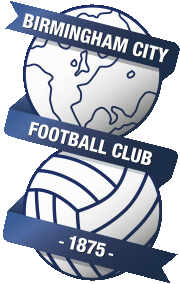
Birmingham City F.C.
Founded: 1875
Also Known As:
SMALL HEATH ALLIANCE (1875-88)
SMALL HEATH (1888-1905)
BIRMINGHAM (1905-43)
BIRMINGHAM CITY (1943-)
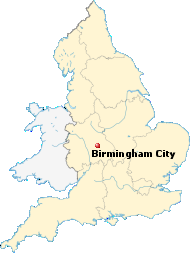
CLICK ON THE MAP TO
VIEW ENLARGED MAP
|
BIRMINGHAM CITY F.C. (Football Club)
Included Info: Brief History, Club/Stadium Info, Team Jersey & Much More...
BRIEF HISTORY of BIRMINGHAM CITY FOOTBALL CLUB
(reproduced from 'Wikipedia' pages)
Birmingham City were founded as Small Heath Alliance in 1875, and from 1877 played their home games at Muntz
Street. The club turned professional in 1885, and three years later became the first football club to become
a limited company with a board of directors, under the name of Small Heath F.C. Ltd. From the 188990 season
they played in the Football Alliance, which ran alongside the Football League. In 1892, Small Heath, along
with the other Alliance teams, were invited to join the newly formed Football League Second Division. They
finished as champions, but failed to win promotion via the test match system; the following season promotion
to the First Division was secured after a second place finish and test match victory over Darwen. The club
adopted the name Birmingham Football Club in 1905, and moved into their new home, St Andrew's Ground, the
following year. Matters on the field failed to live up to their surroundings. Birmingham were relegated in
1908, obliged to apply for re-election two years later, and remained in the Second Division until after the
First World War.
1920 also saw the debut of the 19-year-old Joe Bradford, who went on to score a club record 267 goals in 445
games, and won 12 caps for England. In 1931, manager Leslie Knighton led the club to their first FA Cup Final,
which they lost 21 to Second Division club West Bromwich Albion. Though Birmingham remained in the top flight
for 18 seasons. The name Birmingham City F.C. was adopted in 1943. In 1947 they won their third Second Division
title, conceding only 24 goals in the 42-game season. When Arthur Turner took over as manager in November 1954,
he made them play closer to their potential, and a 51 win on the last day of the 195455 season confirmed them
as champions. In their first season back in the First Division, Birmingham achieved their highest league finish
of sixth place. They also reached the FA Cup final, losing 31 to Manchester City in the game notable for City's
goalkeeper Bert Trautmann playing the last 20 minutes with a broken bone in his neck. The following season the
club lost in the FA Cup semifinal for the third time since the war, this time beaten 20 by Manchester United's
"Busby Babes".
Birmingham became the first English club side to take part in European competition when they played their first
group game in the inaugural Inter-Cities Fairs Cup competition on 15 May 1956; they went on to reach the semifinal
where they drew 44 on aggregate with Barcelona, losing the replay 21. They were also the first English club
side to reach a European final, losing 41 on aggregate to Barcelona in the 1960 Fairs Cup final and 42 to A.S.
Roma the following year. In the 1961 semifinal they beat Internazionale home and away; no other English club won
a competitive game in the San Siro until Arsenal managed it more than 40 years later. Gil Merrick's side saved
their best form for cup competitions. Though opponents in the 1963 League Cup final, local rivals Aston Villa,
were pre-match favourites, Birmingham raised their game and won 31 on aggregate to lift their first major trophy.
In 1965, after ten years in the top flight, they returned to the Second Division.
Businessman Clifford Coombs took over as chairman in 1965, luring Stan Cullis out of retirement to manage the club.
Cullis's took them to the semifinals of the League Cup in 1967 and the FA Cup in 1968. Two years later, the club
raised money by selling Bob Latchford to Everton for a British record fee of £350,000, but without his goals the
team struggled. Sir Alf Ramsey briefly managed the club before Jim Smith took over in 1978. With relegation a
certainty, the club sold Trevor Francis to Nottingham Forest, making him the first player transferred for a fee
of £1 million. A poor start to the 198182 season saw him replaced by Ron Saunders, who had just resigned from
league champions Aston Villa. Saunders' team struggled to score goals and in 1984 they were relegated. They
bounced back up, but the last home game of the 198485 promotion season, against Leeds United, was marred
by rioting, culminating in the death of a boy when a wall collapsed on him. This was on the same day as the
Bradford City stadium fire, and the events at St Andrew's formed part of the remit of Mr Justice Popplewell's
inquiry into safety at sports grounds. The club lacked stability both on and off the field. Saunders quit after
FA Cup defeat to non-League team Altrincham, staff were laid off, the training ground was sold, and by 1989
Birmingham were in the Third Division for the first time in their history.
Birmingham's first top-flight season for 16 years finished in mid-table. Loan signing Mikael Forssell's 17 league
goals helped Birmingham to a top-half finish in 200304, though performances and results tailed off badly towards
the end of the season. In July 2007, Hong Kong-based businessman Carson Yeung bought 29.9% of shares in the club,
making him the biggest single shareholder, with a view to taking full control in the future. Uncertain as to his
future under possible new owners, Bruce left in mid-season to become manager of Premier League rivals Wigan Athletic.
His successor, Scotland national team manager Alex McLeish,[53] was unable to stave off relegation, but achieved
promotion back to the Premier League at the first attempt, and a ninth-place finish, their best for 51 years, the
following season. In 2011, they combined a second victory in the League Cup, defeating favourites Arsenal 21 with
goals from Nikola igic and Obafemi Martins and securing qualification for the Europa League, with relegation back
to the second tier.
|
CLUB FACTS & INFORMATION
| Official Name
| --
| Birmingham City F.C. |
| Club Nickname
| --
| The Blues |
| Year Founded
| --
| 1875 (141 years ago) |
| English County
| --
| West Midlands |
| Current Ground
| --
| St. Andrew's Stadium |
| Ground Location
| --
| Birmingham, England |
| Club's Owner
| --
| Trillion Trophy Asia |
| Club Chairman
| --
| Cho Hung Paul Suen |
| Current Manager
| --
| Harry Redknapp |
| Current League
| --
| Championship |
| Last Season
| --
| Championship, 19th place |
HOME COLORS

Royal Blue & White |
AWAY COLORS

Red, Yellow & Black |
|
| |
INTERESTING STADIUM FACTS & INFORMATION

ST. ANDREW'S STADIUM
St. Andrews Ground, Birmingham
West Midlands, B9-4RL England
OPENED: ......... December 26, 1906
SURFACE: ........ Grass
COST: .............. £10,000
CAPACITY: ...... 29,409
RECORD: ......... 66,844 (1939 vs Everton)
OWNER: ........... Birmingham City F.C.
OPERATOR: ..... Birmingham City F.C.
FIELD SIZE: ..... 109 x 72 yards (100 x 66 meters)
|
|
|
HOME JERSEY
 |
AWAY JERSEY
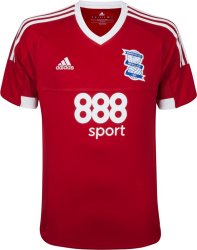 |
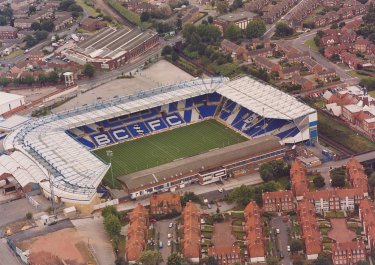
Click On Aerial Photo To View/Download Enlarged Image
|
St. Andrew's Stadium (Birmingham) Seating Diagram
Click On Diagram Below To Enlarge View
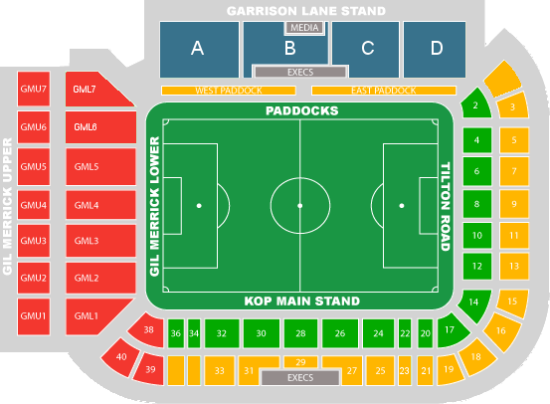
|



BIRMINGHAM CITY STADIUM WALLPAPERS (Free Download)
Wallpaper Size below is 800x600: To Download Bigger Sizes, Click On Any Button Shown Above
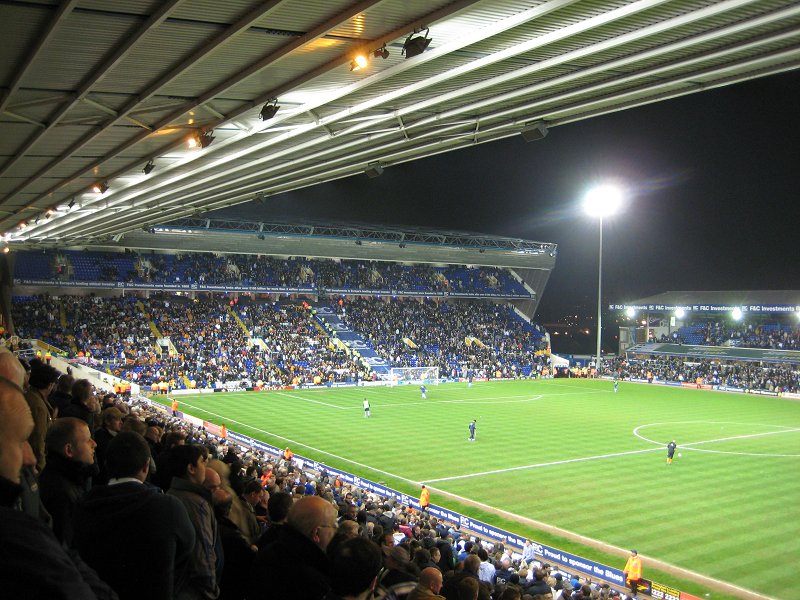
|
|

